Thursday, August 31, 2006
TWILIGHT IN METRO MANILA

I had to be in Makati City this afternoon. I took this photograph while walking along Chino Roces Avenue on my way back to Greenbelt.
Back at home, while reviewing all the shots I took today, I picked this one out to use as the accompanying photo to my entry for today. However, I ended up just staring at it. I couldn’t come up with anything to write about.
So I decided to just write down the first word that comes to mind — appreciation.
And then just leave it at that.
I very much appreciate my articles and photos appearing on fellow bloggers' sites, popular broadsheets, and local broadcast news segments, but I would appreciate even more a request for permission first.
Thank you!
*
Labels: life in Manila, sunset
posted by Señor Enrique at 10:44 PM
| 24 comments
![]()
![]()

Wednesday, August 30, 2006
A GIFT FROM THE UNIVERSE
 This Tuesday was supposed to be uneventful. I only had one errand to attend to — stop by my alma mater, Mapua Institute of Technology over in Intramuros to request for a particular school record which I had been reneging on doing. From SM Manila Mall, I decided to just walk it.
This Tuesday was supposed to be uneventful. I only had one errand to attend to — stop by my alma mater, Mapua Institute of Technology over in Intramuros to request for a particular school record which I had been reneging on doing. From SM Manila Mall, I decided to just walk it.Many thoughts came to mind while enjoying this late morning walk; foremost was the release at this time of the year of New York City’s schedule of Fall-Winter events — music, theater, and dance. As much as grand and awe-inspiring these presentations are and have always been, I always kept an eye out on avant-garde and experimental performances usually held at Brooklyn Academy of Music and The Public Theater at Lafayette Street in downtown Manhattan. There are also obscure venues all over the city that host such mind-boggling, cutting edge performances.
Anyway, as I neared the gate of MIT, to my right is a walkway that leads up to the wall of Intramuros. I thought it would be a good idea to check out; hoping the view from up there will be of photographic interest.
It sure was! And as I marveled at its vista and started photographing, I heard some kids below beckoning me to take a picture of them, which I did much to their delight. This reminded me of what Sidney and I talked about — most folks immensely enjoy being photographed; my mother, of course, among them.

I then went back to my original intention and took more shots of this part of Intramuros, including a shot of Manila City Hall’s clock tower. I continued to walk along the wall — thinking how this place reminds me so much of Old San Juan in Puerto Rico. It seemed as if there was only one architect that built both places, though in San Juan, their Intramuros is called El Moro.
I was somewhat startled from my thoughts when as if suddenly, two figures appeared before me — they were on top of one of the antiquated canons; two kids from the same group I had taken a picture of earlier. Obviously, they wanted another but closer picture of them for me to take so, I once again gladly obliged.

Up close, I realized their costumes were made from rice sacks; nothing at all like what I had originally perceived — tribal costumes from some faraway Philippine province. It piqued my curiosity enough to start asking them questions. They weren’t part of the Department of Tourism’s WOW special program, but rather contestants to a competition being held at their school nearby; scheduled at one o’clock that afternoon.
I then walked over towards the rest of their group and introduced myself to their performance coach/teacher. He briefly told me about this competition being conducted by the school's Pilipino teachers. I then asked in jest if it's true that like Ramon Magsaysay High School students, Manila High School is also made up of very smart students. They suddenly became too shy to respond, but they all invited me to come and see the competition as their guest. I promised them I would.
Right after concluding my errand at MIT, had a quick lunch at the nearby 7-Eleven, and then crosed the street towards the gate of Manila High School. After trading my photo ID for one of their visitor passes, I was shown the way to the school’s grounds were the event was to take place. And there I began to see some students dressed in other theatrically-inspired garments.
The event started as scheduled and I was immediately captivated by the performance of the first group, and then eventually by the rest. Their cheerful faces on these photographs were unlike the demeanor they possessed during their respective performance. These young people seemed like seasoned stage artists with attitude filled with heart and soul. I was very much impressed, indeed; in fact, teary-eyed at some point. They were simply amazing.

The theme of the competition was to interpret a piece of Filipino poetry about Philippine pride. Their performance as a whole was really hard to define or confine to a particular context — it was in essence, avant-garde theater at its best! If they were doing music, I’d easily define it as jazz. It was pure theater; not sure if they were even aware of it, for they all seemed simply immersed in the Zen-like bliss of their performance.
Mrs. Magalong, a Pilipino teacher and the event’s director, asked me to return this Friday to get a copy of this piece (which I intend to post along with more pictures of these students’ while in performance so as to enable the readers to gain better appreciation of these young people’s passion). She also invited me to watch another of the school’s program scheduled on that same day, which made me feel so lucky and honored.

I once learned the universe gives us whatever it is we harbor in our thoughts. And since last weekend, I was much absorbed with New York City’s cultural events usually scheduled to begin in September; making me long for them. And although I don’t particularly enjoy New York’s late fall and winter months, going to these shows helped me cope with New York’s unendurable chilly weather.
And with these thoughts permeating my consciousness, the universe presented me with that walkway in Intramuros, and upon taking the detour it presented, I was led to a string of magical-like turn of events; its highlight was my getting invited to an incredible avant-garde performances by Manila High School’s intensely gifted students.
I praise this school and its dedicated teachers for inspiring these young minds to nurture and manifest their artistic skills! How I wish my old high school — only a few meters away — was this much fun.
I wish to thank the students and teachers for their invitation, but most especially for their having brought a piece of Manhattan to Manila even for a couple of hours. For that alone, I am most grateful.
I will post the second part of this entry as soon as I get a copy of the piece from which their performances was based from.
Labels: life in Manila
posted by Señor Enrique at 10:38 AM
| 35 comments
![]()
![]()

Tuesday, August 29, 2006
SPOONFUL OF LECHE FLAN
 This is my all-time favorite dessert — leche flan or crème caramel; a custard dessert with its top layered with soft caramel.
This is my all-time favorite dessert — leche flan or crème caramel; a custard dessert with its top layered with soft caramel. Supposedly French in origin, it has spread across Europe and has become known as flan in Spanish-speaking countries. European restaurants love the ease of making it. It can also be prepared in advance, chilled, and served as needed.
Crème caramel is a variant of plain custard (crème) where some caramel syrup is poured into the mold before adding the custard base. After the custard has set, it is turned out, leaving a caramel sauce on top. Like all custards, flan is made with whole eggs, milk or cream, and sugar. The typical flavoring is simply vanilla.
As a kid, whenever my parents took me to fiestas or wedding receptions in which the meals are served buffet-style, almost always, my mother had to ask the host if I could be given a piece of leche flan first; otherwise, I would just as easily spend the entire affair playing with my cousins and not eat. The main dishes held no interest for me, only the desserts; specifically, the flan. Once I had a piece, I would then eat some of the main sumptuous dishes.
In New York City, one of my brothers really excelled in making leche flan. However, whenever I had sudden cravings for it, I’d often stop by Dean & Deluca down in Soho and just get myself some crème burlee. At some restaurants here in Metro Manila, many now offer crème burlee, but leche flan is still my prime choice.
While vacationing in Subic as a youngster, my aunt who had a poultry business would always delight us with leche flan every Sunday. This was her way of thanking us for helping her gather the eggs from the chicken coops in the afternoons. However, there was once an incident which made my aunt to never allow me to gather eggs without the supervision of one of her maids. You see, she once caught me pushing back the egg with my finger as the hen labored desperately to lay it once and for all.
By the way, she was the same evil aunt who unmercifully crucified and burnt my pet pig at the stake. If it wasn’t for her leche flan, I would have never returned to her house for vacation ever again.

Labels: Featured food, Growing up memoirs
posted by Señor Enrique at 8:31 AM
| 22 comments
![]()
![]()

Monday, August 28, 2006
FOOD BINGEING AT CHINATOWN BINONDO
I heard about some of its good restaurants such as the Lido along Alonzo Street; the original Lingnam Restaurant known for its fresh noodles; and the eateries along the estero such as Grand House that people rave about.
And for some quick meals Chinatown offers the original Mey Lin along Carvajal Street, Shin Tong Yon on Benavidez Street, and Ha Yuan Restaurant on Masangkay Street.
So many things had changed during my absence. And since coming back, The President was the only restaurant I would go to whenever I find myself in Chinatown. As much as I love the foods served at this fine restaurant, I was craving for other places. I guess it wasn’t just the food; I was trying to get that old feeling back -- the time when my father and I used to walk on these streets.
My old friends and relatives weren't of any help. They don’t feel inspired to venture into Binondo’s narrow streets anymore. Besides, a lot of fine Chinese restaurants had opened all over Metro Manila that offer lots of parking to boot. But I wanted to reacquaint myself with the authentic Binondo eateries. And this inner desire led me to sign up for Ivan Mandy’s Big Binondo Food Wok — an afternoon of history lessons and several authentic Chinese food stops.
I had a wonderful time! Ivan is really good at what he does. Let me put it this way, everyone in this particular tour group was having such a good time that the intermittent showers throughout the entire afternoon didn’t even bother any one of us.
There were other bloggers who joined this particular tour and whom I had the pleasure of meeting. I will leave it up to them to share with the readers the full extent of the tour. What I plan to do instead is go back to those places that Ivan Mandy introduced us to, order a couple of entrees from their menu, and then blog about it.

Labels: Binondo, eateries, Featured food
posted by Señor Enrique at 4:46 PM
| 32 comments
![]()
![]()

Sunday, August 27, 2006
TWO WEDDINGS AND A FOOD TRIP

Imagine this: In a single day, I had gone to four houses of worship, witnessed two weddings, attended a centering prayer meeting, walked through Rizal Park, rested my weary feet at the lobby of Manila Hotel, enjoyed a walking tour of Manila’s Chinatown, and met fellow bloggers for the first time.
It all started at Malate Church. I had misread Beth’s of KaleidosThoughts SMS message to meet her at Ermita Church to attend their centering prayer meeting; I ended up at Malate Church instead. However, rather than rush over to Ermita Church where she was, I watched a grand wedding being held at Malate church. With the area teeming with luxury cars, private chauffeurs and security personnel, I could only surmise many important people were in attendance.
Beth’s centering prayer workshop was a whole day affair, but only stayed for about half an hour; twenty minutes of which were learning and participating in meditation — definitely soothing for both mind and body. Immediately afterward was a ten-minute break, and then I had to say goodbye to her.
 Originally, I invited Beth to join me in this Chinatown food tour, but she had another church-related activity to attend to. She did, however, promise to act as my guide for an evening walking tour of Plaza Lawton later this year when most lights at government buildings will be turned on for the holiday season.
Originally, I invited Beth to join me in this Chinatown food tour, but she had another church-related activity to attend to. She did, however, promise to act as my guide for an evening walking tour of Plaza Lawton later this year when most lights at government buildings will be turned on for the holiday season.Before heading over to Binondo to join up with Ivan’s Big Binondo Food Wok, I stayed around to witness another wedding, but this time at Ermita Church. It was much simpler than the wedding earlier at Malate Church, but nonetheless, everyone seemed just as excited and jubilant.
I still had some time to kill before heading to Chinatown so I headed towards Kalaw Avenue and then to Rizal Park. Although a cloudy day, I took a picture of the hero’s monument. There were many tourists (Koreans) having their pictures taken in front of the monument; therefore, I wasn't able to take a shot from dead center; had to do it from the side.
 Only a block away is one of Manila's grand hotel. Last time I was in the area, I only had enough time to take a picture of its façade, though the guard advised it was all right to take pictures of the hotel’s beautiful lobby as well. At that time, I was running late for Carlos Celdran's Intramuros tour and didn't have enough time to do it.
Only a block away is one of Manila's grand hotel. Last time I was in the area, I only had enough time to take a picture of its façade, though the guard advised it was all right to take pictures of the hotel’s beautiful lobby as well. At that time, I was running late for Carlos Celdran's Intramuros tour and didn't have enough time to do it. However, I had more time this Saturday to take some pictures of its interior, as well as lounge for a little while to appreciate its hunongous but warm ambience. Take note of the wooden ceiling and the capiz shell shades of the huge brass chandeliers. Also had an opportunity to chat briefly with one of the hotel's security managers who has been working there for ten years. He mentioned that as the years passed, there were less high profile personalities to be seen in the premises or checking in as guests. Perhaps, the Mandarin Hotel in Makati has taken over as the city's most prestigious and luxury hotel.
 From Manila Hotel, unable to find a calesa to take me to Binondo Church; decided to cab it instead. I rarely take cabs these days so I also took this opportunity to strike up a conversation with the driver to sort of ask for some driving tips.
From Manila Hotel, unable to find a calesa to take me to Binondo Church; decided to cab it instead. I rarely take cabs these days so I also took this opportunity to strike up a conversation with the driver to sort of ask for some driving tips.Incidentally, before I started driving in the city, I asked a number of taxi drivers for their advice. I was rewarded with valuable information which prevented me from getting overwhelmed or aggravated by the city's trafic jams.. Be that as it may, to this day, I don't particularly enjoy driving over at Makati mainly because of its strict and ever-changing traffic schemes.
There was a mass going on at Binondo Church when I arrived so I decided to attend it. Right afterwards, I noticed some people taking pictures; thought they must be part of the same walking tour that I had signed-up for. I was right.
It was past twelve by that time and I was beginning to feel hungry. I knew that eating at some of Chinatown's retaurants was the highlight of this tour so, just to appease my grumbling stomach, I crossed Ongpin Street to get some hopia at Eng Bee Tin.
Ivan soon showed up and our walking tour started. Much to my pleasant surprise, a visit to one of the older Chinese temples in the heart of Chinatown was an added treat, for I have never been inside one.
It was indeed a pleasure to have finally met Sidney Snoeck of My Sari-Sari Store, who for more than the past six months — along with Irene aka Niceheart of Journey to Honeyville — has been most generous with his support and encouragement in honing my blog writing skills.
It was also quite exciting to have met other bloggers on this food trip such as Ejay and his girlfriend, Pi; a wonderful couple, I must admit. As for Irene, I have a hunch we'll get a chance to meet when I attend her son Reggie’s concert either in New York City or at Newport, Rhode Island for its famed summer jazz festival.
This has been one of the most hectic Saturdays I’ve ever had in quite some time, but absolutely enjoyed every minute of it.
I will post a separate entry about the food trip; for now, feast your eyes on these Chinese delights!

Labels: Binondo, Featured food, walking tour
posted by Señor Enrique at 6:16 AM
| 40 comments
![]()
![]()

Friday, August 25, 2006
ON BOOKSTORES & BOOK FAIRS

This is an oasis in the midst of Makati’s business center — Greenbelt Mall; a wonderfully-designed sprawling commercial complex. Its overall architecture was designed to blend with its surrounding landscape; retaining both its urban and natural characters unlike the ubiquitous fully-enclosed monolithic template of SM Malls.
This mall offers numerous dining, entertainment, and shopping establishments, but among my favorites is Power Books. It comes close to New York’s Barnes & Noble and Border’s bookstores with its well-organized, wide selection of books, comfortable sitting areas, and a coffee shop. It also offers special events such as talks, exhibits, contests, poetry readings, group discussions, book clubs, author visits, book signings, and much more! In addition, this bookstore offers book reservation and special order services (Greenbelt 4 branch telephone: 757-6428 or 29).
Speaking of books…
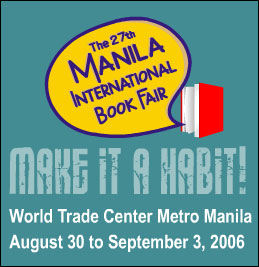
Yes ... it's a book fair!
It’s the 27th Manila International Book Fair to be held at World Trade Center Metro Manila, Financial Center Area over at Roxas Boulevard (Gil Puyat Avenue corner. Diosdado Macapagal Boulevard).
Exhibit Schedule: August 30 to September 3, 2006 -- 10am to 8pm, daily
I must admit, found out about this only recently through micketymoc’s Stepping on Poop site. If you’re planning on going, please let us know; we might all hook up or something.
Labels: life in Manila
posted by Señor Enrique at 6:17 PM
| 29 comments
![]()
![]()

LECHON FOR THE BIRTHDAY MOM

It’s Mama’s 88th birthday today!
When I asked her what she would like for her birthday, she simply said lechon. Metro Manila’s lechon central over at La Loma, Quezon City is only a few minutes away so lechon she’ll have.
She's in relatively good health, though no longer able to tango or rhumba, but she has always been proud of the fact that she can eat anything she desires; unlike some friends with dietary restrictions. She does, however, suffer from bronchial asthma intermittently, though not at alarming frequency.
I had originally planned on taking her for a day trip to The Field of Faith in Laguna, which I discovered though Cathy’s blog entry. However, it has been raining during the past weekends.
We'll just stay home for her birthday and invite over a few friends and relatives. We’ll take her to Laguna another time when the weather is more conducive for her to do so.
Labels: Featured food, lechon
posted by Señor Enrique at 7:12 AM
| 28 comments
![]()
![]()

Thursday, August 24, 2006
GALANG MATERNITY CLINIC
 Five of us were born in this clinic at Batangas Street near Jose Abad Santos Avenue in Santa Cruz, Manila.
Five of us were born in this clinic at Batangas Street near Jose Abad Santos Avenue in Santa Cruz, Manila. Galang Maternity Clinic once did a thriving business by catering to the pre-natal care and birthing needs of mothers in these Santa Cruz and Tondo districts of Metro Manila. It was walking distance from where we lived.
This clinic was established by a hardworking husband and wife doctor team from Pampanga. At the height of their clinic’s success, they built another building right next to it to accommodate the ever increasing number of patients. Even two of my mother’s step-sisters worked here doing odd jobs while pursuing evening school; one of whom would later marry a co-worker.
However, nowadays, this building and the one next to it stand empty with a for sale sign prominently nailed above the doors. It has been in the market for many years with no takers. Some nearby residents even claim they’re haunted. From what I understand, the clinic eventually shut down its doors after the retirement and deaths of both doctors/owners.
The Galangs also had two adopted girls about the same age as me and my sister (who is a year older). And whenever my mother would visit with Dr. Galang, my sister and I would tag along to play with her adopted daughters; one, Angie, suffered from what I believe was cerebral palsy. I remember her as being unable to hide her crush on me. Whenever I showed up, some of the clinic staff would tease her as she came out flashing her toothy smile. When The Rolling Stones later released their song, “Angie,” it would always remind me of her.
There was also a famous movie star, a niece of Dr. Galang, who seemed to be always there whenever not working on a film. It felt strange to be playing around and have this popular actress sitting nearby on the couch as she read her magazines or chat away with friends on the phone. And just like on the silver screen, Amalia Fuentes was truly a beautiful and charming woman. Since retiring from the movie industry, from what I heard, she is now pretty much occupied by her grandchildren and real estate ventures.
And so, whenever I take Batangas Street to visit with friends in Tondo or head towards Divisoria, I tend to slow down the car a notch as I pass by these empty buildings.
Labels: Growing up memoirs
posted by Señor Enrique at 10:15 AM
| 26 comments
![]()
![]()

Wednesday, August 23, 2006
MANILA HOTEL

A premier hotel in the Philippines since 1910, it is a grand hotel where many American governors-general and Philippine presidents entertained their foreign guests — from kings and queens to prime ministers. General MacArthur called it home for many years while the Manila Rotary Club hold its meetings there from the very beginning. A world class hotel, though understated, it has become a venue of collective memories for many Filipinos who had attended one of the many business or social functions held there.
A few fond memories I have of this hotel; foremost was my cousin’s debutant ball in which two older brothers were part of a group of eighteen pairs of young men and women who danced the traditional cotillion. I was barely a teenager then, but remembered having a wonderful time dancing with my cousins and friends during that entire night.
But the most special of all was my memories of Manila Hotel when much younger — the Saturday evenings when my father and mother would go there for a formal dinner/dance, or to enjoy a live concert performance by local big bands or foreign music artists. My father, in a black tuxedo, seemed like a black velvet jewel box casing a precious gem — my mother; all dressed up in a flowing evening gown that seemed to sway ever so gently with her every move.
From the second floor window of our house, I would watch them as they stepped into my uncle’s car. And even at a very young age, influenced by the glamorous Hollywood movies I had seen with my father, I knew I would want to experience that same romantic scene with a girlfriend someday when I got older.
It was peacetime, as they would say, when my mother met my father for the first time. She was still a student/resident of La Consolacion College (not St. Rita’s as I had erroneously written on a previous entry; it was my sister a year older who went to St. Rita’s College). My mother’s aunt, a nun, held an important teaching post in that school. Grandmother had already passed away so raising my mother and her only sister was my grandfather’s most important priority then (he would later marry a second time and produce a number of step-sisters and brothers for my mother and aunt).
My father, already a successful businessman was tiring of living a life as a bachelor; done with his running around, so to speak, and now ready to settle down. When he attended one of La Consolacion’s fundraising events, he met my mother and fell literally head over heels for her.
Right after this initial meeting, my father aggressively sought out and charmed my grandfather; convincing him that he would make the perfect husband for his daughter. Immediately after my mother’s graduation, grandfather advised my mother she was to marry my father. She became distraught. She hated the idea of marrying a man eighteen years her senior; someone she knew nothing about nor loved. However, she had no other choice but concede to my grandfather’s wishes; letting go of her dreams to pursue college and someday marry a man she could truly love.
My mother was grief-stricken by this arrangement, but the wedding went ahead as planned by my grandfather and father. My father knew my mother wasn’t in love with him and made it his quest to make her fall in love with him even if took him a lifetime to achieve it. So, right after the wedding, the courtship for my mother’s love began; it was to last until death do them apart.
Fortunately, for my father, it didn’t take long for my mother to finally acknowledge, appreciate and reciprocate the true love my father had for her. However, despite his victory, my father continued this courtship much to my mother’s delight. He was that much in love with her.
On those Saturdays when I went with my father to his office, usually before going home, he would also buy something for my mother however simple or mundane the item may be. What was more important was he had something to give her when he got home that Saturday evening.
However, with all due respect, as much as my parents celebrated such offerings as romantic and symbolic of his love for her, there came a point in time when such gesture on his part bordered on absurdity and embarrassment, mind you.
Searching fo gold trinkets at Ongpin was fine, but dragging me over to Berg’s at Escolta on a late Saturday afternoon to look for the latest bras or girdles for my mother was just too much. And this was when I was already in high school. And whenever I alluded that perhaps, it was a bit too intimate or personal an item for the two of us to be buying instead of allowing my mother to shop for those things herself, my father would just give me his trademark if-looks-could-kill kind of stare.
So, I would just shrug my shoulders and roll my eyes whenever I heard him say to the saleslady, “I’ll take three and please have them gift wrapped.”
A couple of years after my father’s demise, my mother, to assuage her loneliness, began to entertain suitors. However, in the end, she opted not to remarry. She had learned to love my father as much as he loved her, and was very much content with that. Apparently, he filled her heart with enough love to last until the time comes when they meet again in the afterlife.
Labels: Growing up memoirs, Manila history
posted by Señor Enrique at 9:45 AM
| 22 comments
![]()
![]()

Monday, August 21, 2006
WHEN TEARS FALL

Like most youngsters, I could enjoy playing with my siblings, cousins and neighborhood playmates, as well as playing just by myself; letting loose my imagination with my toy soldiers or small collection of Matchbox cars. I would often do it at the living room where my mother and aunts congregated for their leisurely conversations.
Hearing some of their talks, I could remember what my mother often answered when sometimes asked what it was she was most grateful for -- the opportunity to raise her children in time of peace.
Although my mother rarely spoke about it, she went through harrowing experiences during the Japanese occupation of the Philippines. At that time, my three eldest siblings were already born, though the youngest was a mere infant then. With my father being hunted by the Japanese for having provided munitions to some guerilla forces in Zambales, she and my father spent most of the occupation period evading capture; moving from province to province, as well as hiding up in the mountains with three young kids in tow.
She was also stricken with malaria a month or so before liberation. Had it not been for a couple of guerillas who braved the treacherous travel to meet the American forces to get the required medicine, she never would have made it. Thus, having lived through such perilous wartime experiences, she would become a mother obsessed with providing comfort and safety for her children — to a fault at times.
Summertime in our house during my childhood would always include my aunts in Subic sending over two of their maids to help out. Our maid needed all the help she could get, for there were constant piles of laundry from eight kids taking at least three baths a day.
And to her five boys, our mother’s primary rule of behavior towards the opposite sex is to never make them cry. She would also relentlessly remind us that if ever we touched disrespectfully any of the household help, she would have the culprit marry the maid. Period.
It wasn’t until I got older that I realized our mother’s concern for our maids in particular and with women in general. It was borne by the gruesome acts against women that were committed by the Japanese military forces during the war, which my mother had partly witnessed or heard directly from some of the survivors she had met at the camps in the mountains.
Like all lessons taught by our mother, I brought it with me into adulthood, but since I grew up during the era decades after the liberation, I soon forgot about these war crimes until I found this book at the National Bookstore the other day by Armando A. Ang, “The Brutal Holocaust — Japan’s World War II Atrocities and their Aftermath.” I was compelled to purchase it.
The Japanese, according to this book, have always considered themselves to be a chosen people by divine providence. Its mission was to conquer and rule other countries. Jimmu Tenno, the first emperor of Japan, was said to have given the divine command, Hakko Ichiu, to bring the world under its rule. This divine command has been resurrected several times in its long history.
The militaristic nature of the Japanese then — its culture of extreme brutality and fanaticism from the past — impacted the Japanese society as a whole for centuries. Early in life, children were indoctrinated into believing that they were a superior race and that others would eventually serve them, especially the white prisoners of war who would dishonor themselves by surrendering. In short, they were racist and racism was adopted as part of their life. Their ancient Shinto religion, strongly nationalist and racist in character, was fosterd whole-heartedly. Hence the Chinese were originally singled out and considered subhuman or vermin; killing them was of no major significance. When World War II broke out, the other Asian nations were also regarded as vermin to be annihilated from the face of the earth.
One of the book’s most troubling chapters is about the comfort women. It is not my intention to echo its details, but will only mention that thousands of Filipino women, as well as prepubuscent girls and boys were forcibly abducted by the Japanese forces, and subjected to routine sadistic gang rapes and murder. Such systematic crimes against humanity were common occurrences not only in the Philippines but throughout any Asian country invaded and occupied by the Japanese forces. The most horrific account of which on record was by Iris Chang 's “The Rape of Nanking.”
As for the overall despicable behavior demonstrated by the Japanese invading forces, one historian at the Southern Illinois University had this to say: “In terms of measures and cruelty of the genocide, its duration and large numbers of people killed, neither Hiroshima nor the Jewish Holocaust can rival the Nanking Massacre. The manner in which the victims had met their death was extremely cruel and diverse, so ghastly in fact that it made Auschwitz gas chamber appear humane. The victims of the Jewish holocaust were seldom physically mistreated.”
And because these atrocities were committed by the Japanese mostly against their fellow Asians (Chinese, Koreans, Thais, and Filipinos to name a few) the Americans, led by General Douglas MacArthur never pursued these war crimes to provide their victims, living or dead, their due justice. Yet, to this day, there are thousands of living survivors who are still trying to demand an official apology from the Japanese government and full recompense for their pain and suffering.
This entry is not intended as a general indictment against the Japanese people and society of today, for many things have changed since these tragic wartime events took place some sixty years ago. Political forces have realigned that enemies have become friends and atrocities have been forgotten to the detriment of those whose justice had not been served.
Notwithstanding, it is my hope that we continue to support even in thought the remaining living survivors — especially the comfort women — in their efforts to find justice, recompense, and ultimately, inner peace.
Labels: atrocity of wars, Growing up memoirs
posted by Señor Enrique at 3:38 PM
| 15 comments
![]()
![]()

BONIFACIO AND THE CRY OF BALINTAWAK
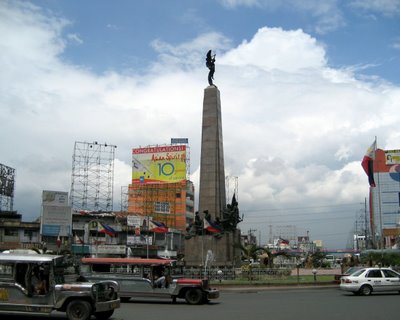
It has been said that we Filipinos have no sense of history. However, according to Ambeth Ocampo, it isn’t so much as indifference or amnesia, but rather our uncertainty as to what or whom to believe. Thus, the easy way out is to simply ignore the past.
Take for instance Andres Bonifacio); how much do we really know about him, as well as his group, KKK (Kataastaasan Kagalanggalangang na Katipunan ng mga Anak ng Bayan)?
To avoid an exhausting historical treatise, Ocampo suggested that we simply look at the world of local art and study how Bonifacio is represented by Filipino artists in the last eighty years in their drawings, paintings, music, and sculpture. He argued that the stereotyped image of Bonifacio as represented in their works goes against historical documentation. Hence, we have two Bonifacios in our national consciousness — one mythical, the other real — and that the myth has become more popular than reality. And therein lies our problem.
As an example, Ocampo pointed out when a sculptor submitted studies for a proposed Bonifacio monument to the National Historical Institute. From his awkward drawings revealed the popular Bonifacio stereotype: one wearing an open camisa de chino to display a muscled chest and pants rolled up to reveal bare feet. On his left hand waved the Katipunan flag, while his right raised a menacing bolo. To highlight this difficult pose, the artist gave Bonifacio fiery eyes and a silent but suggested rebel yell.
To the masses, there is nothing wrong with this image of Bonifacio. It can be seen in full color in the Carlos V. Francisco mural at the Manila City Hall, or in the various cement versions in schoolyards and municipal plazas all over the archipelago. Everything seemingly comes from the same mould or idea.
Ocampo traced the origin of this image to a drawing by Jorge Pineda reproduced on the cover of Renacimiento Filipino of July 14, 1911. From this drawing was born the monument by the sculptor Ramon Martinez, which was unveiled on September 3, 1911, in Balintawak (it has since been transferred and now stands in front of Vinzon Hall in U.P. Diliman).
Thus, that has been how most remembered Bonifacio until it was challenged by the late National Artist for Sculpture Guillermo Tolentino.
After painstaking research and interviews with people who had actually known Bonifacio, Tolentino created a masterpiece in bronze in Caloocan that has become a landmark now known as “Monumento.”
In this monument, as Ocampo illustrated, the artist represented a different image of Bonifacio: one in a closed barong tagalog, with a handkerchief tied on his neck, and wearing shoes! He stands calm but defiant with a bolo in one hand and a gun on the other. Behind him are Emilio Jacinto and a standard bearer with the Katipunan flag.
When the protests poured in, Tolentino countered his critics with his research. The likeness was based not only on a photograph of Bonifacio, but on the bone structure of his sister Espiridiona as well. Interviews with surviving members of the Katipunan gave an idea of his attire and revealed that, contrary to common belief, Bonifacio favored his gun over his bolo in battles. Tolentino even consulted espiritistas (psychics) to discern the true likeness and character of Bonifacio.
Ocampo also cited Bonifacio’s likeness to be elusive, for there is only one faded studio photograph of him in existence as compared to Jose Rizal’s numerous pictures. The irony of it all is that despite the common image of Bonifacio as the barefoot Great Plebian in his camisa de chino and rolled up pants, our sole photograph of him shows him wearing, of all things, a coat!
Aside from Bonifacio’s image, there was also the confusion as to the authenticity of the Grito de Balintawak tradition. Since the turn of the century, it has been widely believed that the first cry of the revolution took place in Balintawak, Caloocan. Then along came Teodoro Agoncillo, our nationalist historian, who gave the exact date for the cry as August 23, 1896, and the exact place to be Pugadlawin, not Balintawak. Despite these becoming textbook facts, according to Ocampo, the Balintawak tradition continues to thrive. And that even Nick Joaquin wrote in support of Balintawak.
This controversy remains unresolved except in our textbooks, but as Ocampo pointed out, depending on the book one should read, there were five dates for the Cry — August 20, 23, 24, 25, and 26 — and five different venues: Balintawak, Pugadlawin, Kangkong, Bahay Toro, and Pasong Tamo. Ocampo, to this day, remains confused and stumped himself.
Source: Bonifacio’s Bolo by Ambeth R. Ocampo
Labels: Featured artist, historical figure, Philippine history
posted by Señor Enrique at 8:27 AM
| 17 comments
![]()
![]()

Sunday, August 20, 2006
A NORMAN ROCKWELL MOMENT
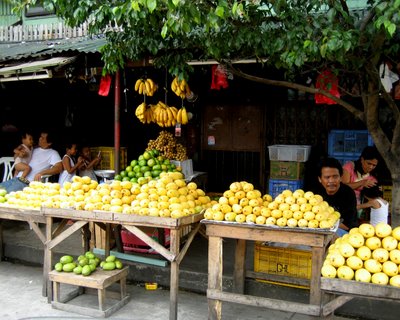
The traffic was unexpectedly heavy last Saturday morning on my way to get my laptop fixed; a virus had invaded it, corrupting the operating system. It was bumper to bumper on Calavite Street over at Blumentritt, but instead of getting bummed out about it, I just sang along with the Beatle tunes playing on the car’s stereo.
And as I belted out "Hey Jude" and turned my gaze to my right, I noticed these tables of ripe mangoes, lanzones, and dalandan; and hanging from the roof are some bananas. I immediately rolled down the passenger side window, snapped a shot, and went back to singing.
However, much to my delight, as I reviewed the pictures I had taken, I just now realized that this particular shot (click to enlarge) is teeming with family life.
Check out the proud father holding his baby while the two kids by his side are giggling over something that one of them is holding. And the man wearing a dark shirt seems to be figuring out who his buena mano (first customer of the day) is going to be as the woman behind him is busily picking out the lice from her daughter’s hair.
I have taken quite a few candid shots, but this one somehow just touches my heart. A simple family scene it may be, but the fruits on the foreground and the kids on the backdrop seem to suggest a bountiful life.
A perfect Sunday photo feature, I thought.
Labels: life in Manila, photography
posted by Señor Enrique at 3:56 PM
| 35 comments
![]()
![]()

Saturday, August 19, 2006
ART STUDENTS LEAGUE OF NEW YORK
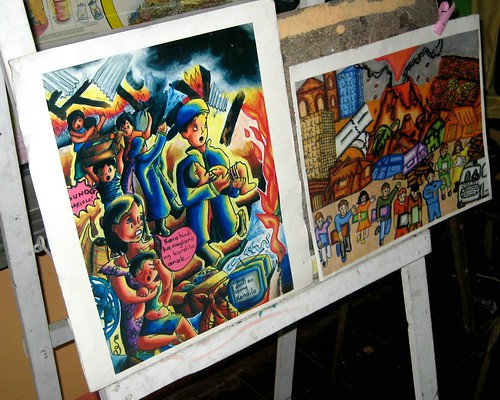 I had once mentioned -- in one of the memes I had done -- that while in New York, I joined the Art Students League of New York and took many of its classes just for the heck of it. Most of my friends then were more into art history books while I preferred to know about art by actually delving into some of its creative process.
I had once mentioned -- in one of the memes I had done -- that while in New York, I joined the Art Students League of New York and took many of its classes just for the heck of it. Most of my friends then were more into art history books while I preferred to know about art by actually delving into some of its creative process. The school was only a couple of blocks from where I lived and there was nothing more exhilirating to do on a Saturday morning than attend one of its art workshops — be it basic drawing, painting, printmaking, or sculpting. I didn’t turn out a fine artist as our friend Rey Villegas, but those classes expanded my appreciation for anything art. Also, I met a lot of other interesting people who wanted to fulfill a longing to immerse in it despite their lack of talent for it. It was the actual participation in art that we sought and for which we were rewarded with expanded horizons.
The school, by the way, has a very interesting history.
During the 1870s, New York was becoming the artistic capital of America with National Academy of Design as its major art institution. The Academy was founded in 1825 and one of the oldest organizations of its kind in the country. For an artist to have his works selected as part of its annual exhibitions was a significant accomplishment in itself. Thus, gaining full membership at the Academy had become a major goal for many.
However, by the mid-1870s, the Academy was finding itself unable to meet the needs of the growing number of artists joining this profession. There were also many young artists fresh from their studies abroad who were dismayed to find the established members of the Academy too conservative and unable to understand their relatively radical ideas and more sophisticated attitudes toward art. This led to the subsequent creation of the Society of American Artists.
In great part, this development reflected the conflict between the "old guard" at the National Academy and the young rebels: conservative versus progressive, insular as opposed to cosmopolitan. Notwithstanding, with a rapidly growing number of artists flocking to the city, the annual exhibitions of the Society of American Artists helped to alleviate the problem of not enough exhibition space at the National Academy. However, it was the Society itself which provided the more progressive artists with their own forum.
As if in lock step, a similar development took place in the spring of 1875, when the National Academy began experiencing financial difficulties and planned to cancel all classes its until December. Students were alarmed because the Academy now required them to devote the first ten weeks of each school session to drawing; whereas, painting from life, their main interest, wouldn’t be until February of the following year. Even more distressing was the possibility that there may not be enough funds to hire any instructor to direct them when classes did resume.
Lacking any viable alternative by which art students could engage in any formal course of study from live models, the students met with teacher Lemuel Wilmarth to discuss the matter. The result of their meeting was the formation of the Art Students League. The students of the League soon aligned themselves with, those artists who would soon form the Society of American Artists (and who would later become the chief instructors at the League). Like the National Academy, the Art Students League was established as a membership, but offered membership to any candidate with acceptable moral character and the means to pay his dues. The informal nature of the League's organization was also very different from that of the Academy.
The major reason for the Art Students League's continuous success is mainly attributed to its long line of dedicated teachers and loyal and appreciative students, many of whom subsequently returned to the League to teach. To date, the Art Students of New York remains a cooperative society based on mutual help among all its members. There have never been any degrees or diplomas, no set curriculum; one must be there solely for the love and pursuit of art, the yearning for the exchange of artistic ideas and techniques. It is an institution founded by students for students, and these are the major reasons the school has continued to flourish.
Read the complete history.
Labels: art matters, Life in New York
posted by Señor Enrique at 6:39 PM
| 8 comments
![]()
![]()

Thursday, August 17, 2006
CARLOS CELDRAN ON LOCAL HISTORY
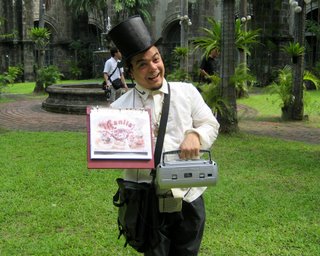 On the book meme I had answered a while back, there was this question — one book you wish had been written — to which I had given a frivolous response. But if allowed to go back to change it, I would say a book on our local history to be written by Carlos Celdran.
On the book meme I had answered a while back, there was this question — one book you wish had been written — to which I had given a frivolous response. But if allowed to go back to change it, I would say a book on our local history to be written by Carlos Celdran.After many months of wanting to join one of his walking tours of Intramuros, I finally did this Thursday afternoon. I was expecting it to be a good one based on responses posted on his comment boxes by those who had already taken it. But much to my surprise, it was even better than I had expected.
Now, I had taken a few guided tours in my past travels, but the one I was in this Thursday was no mere guided touring — it was pure theater; a one man show. The guy is a bonafide performance artist. Plus, he has portable visuals and soundtrack music to go along with his monologue. There were lots of laughter, as well as moments of reflection. It was intense!
My only disappointment was — and this has more to do with me than Carlos — I was both taking pictures (like a typical tourist) and listening to what he was saying about our local history and culture. I should have been just taking notes. However, there’ll be plenty of time for that, because from now on, instead of taking my future balikbayan friends or relatives on local food trips, I will take them on one of these historical tours given by Carlos. It’s that good.
 For expat parents who will be coming back home to visit with their foreign-born children (at least of high school age), these tours are highly recommended, indeed.
For expat parents who will be coming back home to visit with their foreign-born children (at least of high school age), these tours are highly recommended, indeed.Incidentally, I do intend to take his other walking tours.
Labels: Manila history, Philippine history, walking tour
posted by Señor Enrique at 9:34 PM
| 42 comments
![]()
![]()

Wednesday, August 16, 2006
CHINATOWN aka BINONDO
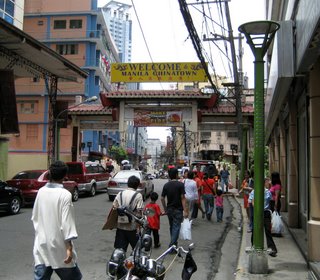 This was the largest town during the 1800s outside of Intramuros.
This was the largest town during the 1800s outside of Intramuros. It was the center of commerce for the Chinese and Filipino businessmen even before the Spaniards arrived and it continues to be a thriving commercial hub to this day.
More than 70% of the goods sold in the provinces are estimated to be directly sourced from wholesalers along Chinatown’s dozens of narrow streets. This area also boasts numerous eateries which attract many people from all over Metro Manila, especially on weekends.
My father, though born in Subic, Zambales, studied in Manila from elementary to college and lived at my grandfather’s cousin’s house in Binondo; only to return to Subic during vacation. After graduating from college, along with his cousin as partner, they set up a business at Florentino Torres Street near C.M. Recto Avenue.
From the time I was old enough to go to the bathroom by myself, my father started taking me along to his office on Saturdays when he worked only until lunchtime. I was a quiet, cooperative child and could be left on a chair near him as long as I have a favorite toy in my hand to keep me occupied. But when I turned eight or nine, there were times boredom would spur me to sneak out of the office and gallivant on my own around Chinatown. Confident with my basic know-how of the various twists and turns of some of its narrow streets, I would usually end up at my favorite place -- the pet shop that my father and I always passed by on our way to eat lunch.
It had a gigantic aquarium filled with exotic salt water fish. The nice Chinese proprietress would lend me a stool to sit in front of it. And while I ate a bag of buchi or mini hopia I bought from the nearby street vendors, I would make believe I was an underwater diver. This would go on for quite a lengthy period until I would get a tap on my shoulder from that nice Chinese lady as she pointed to the wall clock nearing 12. I would then thank her and run back to my father’s office.
At lunchtime, as we passed by the pet shop on our way to a restaurant, the nice Chinese lady would wink at me as if to celebrate our little secret. This escapade went on for quite some time until my father noticed my disappearing act and had his messenger, Tito, trail me. Once settled on the stool to watch the newly-arrived batch of intensely colorful salt water fish, Tito rushed back to the office and told my father my exact whereabouts. My father decided to leave for the day an hour earlier than usual and came to fetch me at the pet shop.
I was too engrossed by the activities inside the fish tank to sense my father standing behind me until I noticed his figure reflected on the tank’s glass. My eyes widened with fright but before he could utter a single word, the nice Chinese lady stepped out of her counter where the cash register was to greet my father. And from their initial exchange, they appeared to know one another. My father had always been a man of few words but quite articulate when necessary; however, on this particular occassion, he was obviously fumbling for his words.
And before I knew it, my father was buying me a five-gallon fish tank and some of its paraphernalia. The nice Chinese lady then told me to come back and buy the fish another day when the tank had been fully set up; with its water conducive enough for the fish to inhabit. Before saying goodbye to her, my father asked if he could use their telephone to ask Tito to pick up our purchase and bring it home.
We headed for lunch and then to a movie right afterwards. While my father dozed off as usual — lulled by the comfortable cushioned seat and the air-conditioned theater — I sat there fidgeting on my seat. My mind was fixated on my unexpected good fortune earlier. Although I was thrilled to have received a fish tank, I couldn’t figure out why my father got me one even though I was sneaking out without his permission.
I thought perhaps, the nice Chinese lady must have convinced my father to buy me one, but my father wasn’t one to be easily swayed by a sales pitch. Besides, I didn’t hear anything about getting me an aquarium in their conversation; they were merely updating each other about respective family life. I then suspected something else — but even at a very young age, I knew better than to pry so I left well enough alone. These intermittent thoughts, in the end, distracted me enough from enjoying a John Wayne western projected up on the silver screen.
I returned to the pet shop many times since then — now with my father’s permission — because the nice Chinese lady had started to teach me how to breed fresh water Zebra fish, which I later traded for marbles and bubblegum cards with some of the neighborhood kids.
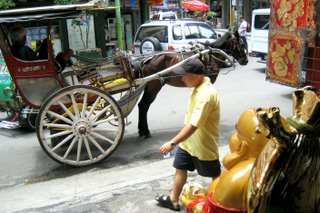 And it wasn't until in high school that I realized I was wrong in assuming that my father and that nice Chinese lady might have shared a romantic liaison in the past (considering they both grew up only a block away from each other). The truth was, the many other surprise gifts and treats that I later received from him revealed the clue: they were mostly things my father never had as a child. And that every time he got something for me to enjoy, it was also as if he were getting it for himself.
And it wasn't until in high school that I realized I was wrong in assuming that my father and that nice Chinese lady might have shared a romantic liaison in the past (considering they both grew up only a block away from each other). The truth was, the many other surprise gifts and treats that I later received from him revealed the clue: they were mostly things my father never had as a child. And that every time he got something for me to enjoy, it was also as if he were getting it for himself.Labels: Binondo, Growing up memoirs
posted by Señor Enrique at 6:13 PM
| 32 comments
![]()
![]()

Tuesday, August 15, 2006
DREAMING OF LA VIDA ESCOLTA

This may be David Street with Escolta up in the corner while Muelle del Banco Nacional (north bank of Pasig River) is right behind.
The two buildings in the above picture: the beige on the left and the mustard on the far right corner are similar to the industrial buildings in downtown Manhattan areas -- Soho and TriBeCa -- which were converted into spacious living lofts. I emailed this picture to a friend in New York and told him that if some of the buildings in the Escolta area like these two were converted into living loft spaces, this neighborhood would make an ideal residence, especially for those who wish to stay in Manila. Gardens could also be set up on the roofs just like on some of New York's buildings.
In addition, living in this area will put you within walking distance to Binondo, Divisoria and Quiapo. And with more residents breathing life into this area, probably more shops will open as well to provide their products and services, not only for the benefit of area residents but also for those coming over to visit -- attracted by the revitalization efforts in the neighborhood.
I can also see more cafes and restaurants, as well as art galleries opening along Escolta, including a super bookstore like those of Barnes & Noble and Borders in New York. Capitol Theater may be reopened to show nothing but art and independent films -- both by local and foreign filmmakers. Even startup companies such as graphic design studios, animation companies and call centers may be given tax incentives by the government if they were to locate their operations in the area, as well as for offering summer internship programs to the students of the nearby city college. I don't exactly know how safe it is here at night, but with a true sense of neighborhood, ample security and adequate exterior lighting, through such gentrification, Escolta may once again regain some of its former glory.

Photo of Polland Café at the corner of Escolta and Nueva/Yuchengco Street; Savory Restaurant is at the corner. At this café is wherethose who sign up for Carlos Celdran’s walking tour meet (Walking Tour of Escolta and Quiapo and the North Side of the Pasig River).
Labels: Escolta, life in Manila
posted by Señor Enrique at 5:56 PM
| 35 comments
![]()
![]()

CAPITOL THEATER ON ESCOLTA
 It was designed by Juan Nakpil in 1935 using local indigenous motifs for its art deco ornamentations.
It was designed by Juan Nakpil in 1935 using local indigenous motifs for its art deco ornamentations.Its front elevations portray Filipinas in their native garb set against a tropical backdrop; depicting more of a distant rural landscape than the usual urbanized setting common in Escolta’s commercial district during the ‘30s.
Capitol Theater is one of the two cinema houses along the strip of Escolta that I remember during my youth; the other is Lyric. Regrettably, like most of the movie theaters on Rizal Avenue where we used to go, it is now closed. The building, however, stands just as majestically as ever.
The most fond memory I have of Capitol Theater was one early Sunday morning. Along with my brothers and cousins, we rushed the Chinese proprietor, Mr. Yu, to bag some special bola-bola siopao and bottles of Coca-Cola for us to take out. He just opened his noodle shop a few minutes earlier, and was now quizzically glancing at us as he hurriedly prepared our order. He knew me because my father and I frequented his eatery near the Santa Cruz Church.
I told him that we wanted to be the very first on line to buy tickets and enter Capitol Theater when it opened that morning. As he handed us our brown bags, he still had that confused look etched on his face so, as if in unison we all yelled in delight, Thunderball!
We were just about to run out of his shop when he yelled for me to stop as he put some buchi in another brown bag. Mr. Yu knew how much I love these fried ground glutinous rice balls filled with sweet mongo bean paste, but I had to tell him I didn’t have enough money for them. He insisted that I take the bag anyway; saying he would just charge my father when he saw him. I grabbed it from his hand while saying a quick thank you and dashed out of his shop to catch up with my brothers and cousins already about to cross the street leading towards Escolta.
Capitol Theater was at that time showing the much anticipated fourth James Bond movie, Thunderball, which starred Sean Connery as British Secret Service agent, Commander James Bond 007. And as planned, with Escolta’s fine shops still closed, we started the line in front of the theater that early Sunday morning.
The release of this movie underscored the people’s insatiable craving for spy stories; reflecting the public’s pervading cold war anxiety and intrigue for the mysterious yet intrepid secret agents. Television producers were also quick to exploit the growing demand for anything spy mania by creating shows like The Man from U.N.C.L.E., I Spy, The Wild Wild West, and Get Smart.
Thunderball further dazzled the James Bond fans with his de riguer transports such as the famous Aston Martin DB5 and the "Bell Rocket Belt" used to escape from a building. There were also the high-tech gadgets such as the waterproof watch and camera with a built-in Geiger counter and the underwater jet pack that was armed with a spear gun. Most astonishing was Bond’s “rebreather” — a small scuba set that can be carried unnoticed and, when used, provided a few minutes of air in underwater emergency.
And of course, there were Bond’s three conquests — Luciana Palluzzi as Fiona Volpe, Claudine Auger as Domino and Molly Peters as Patricia Fearing. Thunderball would later prove to be the most successful of all the James Bond flicks, raking in millions of dollars in box office tickets worldwide. It also confirmed the movie star status of its leading man, Sean Connery.
And so it was. All those fond memories while I gazed at the remains of the old Capitol Theater in Escolta, Manila. As I headed towards Jones Bridge, it suddenly dawned on me what I had seen earlier, but didn’t pay that much attention to — a new building was erected on the spot where Mr. Yu’s noodle shop used to be. I thought of him and the many times my father and I went to eat at his shop -- on late Saturday afternoons after seeing a movie.
Memories indeed linger from which time and tide had washed away.
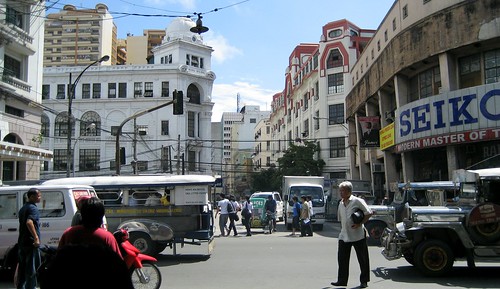
View of Escolta leading to Jones Bridge from Santa Cruz Church.
Labels: Growing up memoirs, Manila movie theater
posted by Señor Enrique at 5:25 AM
| 28 comments
![]()
![]()

Monday, August 14, 2006
168 MALL IN DIVISORIA
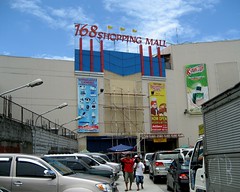
When it comes to shopping, my sister-in-law in New York will sometimes suffer from momentary lapse of reason, though her overall sense of kindness and lack of malice give her license for it.
Take for example the incident last week. As if trying to beat the local time zone’s break of dawn, she called me on my cellphone. She wanted to know what the deal was with this 168 Mall in Divisoria that she keeps hearing about from her recent balikbayan friends.
Groggily, I told her this mall has stores that sell knockoff name brand merchandise from China at dirt-cheap prices. When she asked how the distributors and retailers are able to make any profit, I replied in jest that they were merchandise skimmed off the top portion of humongous shipping containers; that these counterfeit products are primarily used to camouflage the more valuable stuff at the bottom — shabu; otherwise known as crystal meth in New York. But I was wise enough to quickly retract what I had just told her, though there were rumors alleging smuggling at the heart of this mall’s operations.
She is an accountant and has worked at various companies in the fashion industry and cognizant of the adverse affects of this flood of fake products in the U.S. — from the fifteen-dollar Hermes scarf to fifty-dollar Prada clutch bags from China and Korea. And despite the authorities' efforts, smuggled knockoffs remain to be a multi-million dollar headache for both the government and the garment industry.
As a proactive solution, some design houses have created a separate division from within their own organization that would use the same exact patterns of their collection and reproduce them with cheaper fabrications. The result: same look but cheaper prices to be sold at their “outlet stores.” In tony suburbs across America, there are now shopping malls which specifically cater to these designer outlet shops — stores for knockoff items produced by the same companies that created the originals.
The New York Times article, "Fashion’s Cutthroat Edge," provides a rare glimpse into this dilemma and features a blogsite, Counterfeit Chic, which shows just how maddening this counterfeit situation has become. According to this article, the blog site’s author, Ms. Scafidi, an associate law professor at Methodist University, “posts one or two items to which she lends some in-depth, knowledgeable commentary. And each week, she posts a long list of newsy links to articles and blog posts from across the globe about police stings, internecine industry battles and efforts by both governments and fashion houses to somehow stem the flood of knockoffs.”
The success of Divisoria’s 168 Mall is fueled by the government’s lack of stringent efforts to battle the influx of counterfeit products into the local market, as well as by the consumers’ minimal disposable income yet fascination with status-setting designer merchandise, though fake the items may be. It's the "counterfeit chic phenomenon;" buying one of these items for the look and fun of it — until disposed of for another shopping spree.
My sister-in-law is one who appreciates the quality and durability of authentic designer goods — and willing to pay for it, or I should say patient enough to wait until they go on sale, if ever. Her attitude has always been, when she gets tired of them, they would still be in good enough condition to pass on or donate to her church — which could end up in one of those ukay-ukay shops in Bambang. But I opted not to tell her about this new crop of shops that have become popular to local shoppers. I was still sleepy and dying to end our phone conversation by then.
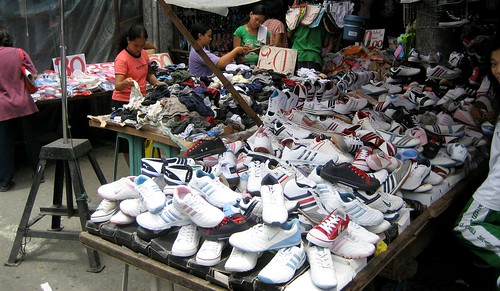 Basically from the same distributor, fake name brand sneakers being sold outside in the streets of Divisoria, as well as inside the 168 Mall.
Basically from the same distributor, fake name brand sneakers being sold outside in the streets of Divisoria, as well as inside the 168 Mall.
Labels: fashion industry, life in Manila
posted by Señor Enrique at 2:47 AM
| 18 comments
![]()
![]()

Sunday, August 13, 2006
STA. CRUZ CHURCH - MANILA
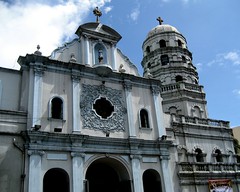
It was built by the Jesuits in 1608 as a parish church for the growing Chinese immigrants in Manila, many of whom had converted to the Catholic faith. When the Jesuits were expelled from the Philippines, the church became Dominican.
The original structure of Sta. Cruz Church was twice damaged by earthquakes; it was completely destroyed during the Battle of Manila in 1945, which totally devastated the entire city and ended the almost three-year Japanese occupation of the Philippines.
When Manila was declared the capital of the Philippine archipelago on June 24, 1571 by the head of the Spanish expedition, Miguel Lopez de Legaspi, the city soon became a replica of a European medieval city with churches, palaces and city halls built in the Spanish baroque style. The present building of the church, completed in 1957, was designed to reflect the architecture of that period. The church’s tower, however, is comprised of a series of sections whose girth decreases as they climb upwards. Their shape and dimensions are reminiscent of the composition of other Asiatic styles of architecture.
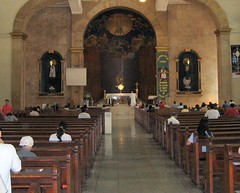
As for its altar, it may seem understated at first glance, but its dramatic lighting is quite awesome, actually.
The church is located at Plaza Lacson (formerly Plaza Goite) in Santa Cruz. It is fronted by Plaza de Sta. Cruz and the famous Carriedo Water Fountain is just directly across the street.
Labels: Manila history, Santa Cruz Church
posted by Señor Enrique at 2:08 AM
| 20 comments
![]()
![]()

Friday, August 11, 2006
ON BOOKS AND WRITERS
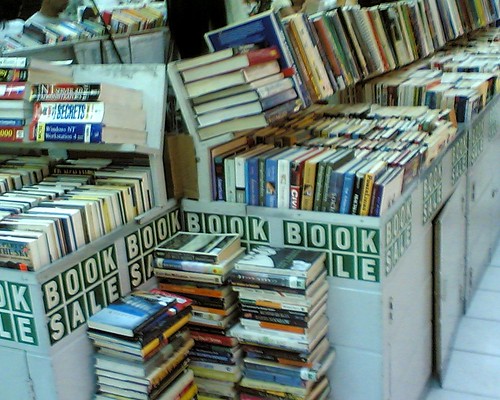
For all blogmates game enough to have done the six weirdness meme a week or so ago — and may now be having regrets for revealing their uniquely strange characteristics — I say don’t sweat it. Check out instead the following five accomplished writers and their peculiar habits*:
- Henrik Ibsen hung a picture of August Strindberg, his mortal enemy, near his writing desk.
- Friedrich von Schiller couldn’t write unless his bare feet were immersed in cold water.
- Jack Kerouac wrote only by candlelight.
- John Steinbeck suffered from the fear of putting down the first line.
- John Cheever used to put on a business suit, leave his apartment, and go to his basement where he would hang his suit on a hanger and proceed to write in his underwear.
We may laugh at them now, but guess who in the end laughed all the way to the bank?
Speaking of writers, recently, I was tagged by a newfound blogmate, Ipanema of Lands End. Her meme is all about books. This, I must admit, has got to be the toughest meme yet only because I’ve read quite a few and to choose one title as the singular response to each of the following questions is absolutely tough. There were instances where I was convinced I was done, but only to go back to make some changes. At one point, it seemed like I was going through one of those neuroses common amongst New Yorkers.
Finally, I just had to say to myself, “Stop it! No more changes. Post the damn thing!”
So here are my responses:
One book that changed your life:
The Science of Mind by Ernest Holmes -- absolutely the finest book on anger management.
One book you have read more than once:
The Alchemist by Paulo Coelho – though small and a quick read, it is truly a feel good book.
One book you would want on a desert island:
U.S. Army Survival Manual – I’ve got to eat eventually.
One book that made you laugh:
356 Daily Instructions for Hysterical Living by Benrik – a celebration of one’s innate desire to be silly and frivolous, but too ashamed to admit it.
One book that made you cry:
Sophie’s Choice by William Styron – the challenge alone of reading it from start to finish can make any grown men cry.
One book you wish had been written:
The Deliriously Blissful Life, A Manual -- to be awarded at birth right after you get slapped on the butt by a masked, white-gowned stranger.
One book you wish had never been written:
The Communist Manifesto by Marx and Engels – it doesn’t work mainly because it lacks an understanding of/consideration for human psyche. Not their fault – when the book was published in 1848, Sigmund Freud (1856-1939) wasn't even born and Wilhelm Wundt (1832-1920) was still a high school student.
One book you are currently reading:
The Passover Plot by Hugh Schonfield – more appropriately, a book I’m currently trying to finish reading
One book you have been meaning to read:
Freakonomics by S. Levitt and S. Dubner – if I could only find a copy here in Manila
Now tag five people:
Since it was a newfound blogmate that tagged me, thought it’d be fitting for me to tag other newfound blogmates as well for this meme. So here you are:
Aurea — Boxing, Grad School, Life…
Bugsybee — Blogging Bugs
Houseband00 — My Life With D (The Houseband Chronicles)
Ladybug — Of Law and Badminton
Wil — Miskina Ano Na Isip
Jhay - Pinoy Explorer
You may post your response on my comment box if you do not wish to post a separate entry of it on your site. Others who may wish to join in the fun can post your responses also on my comment box.
Have fun, y'all!
*Source: Art and Soul, 156 Ways to Free Your Creative Spirit by Pam Grout
Labels: Featured book, Featured Writer, meme
posted by Señor Enrique at 9:07 PM
| 30 comments
![]()
![]()

THE BRIDGE, THE RIVER & THE YOUTH OF MANILA
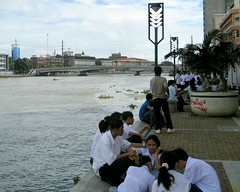
A clear and breezy afternoon along the north promenade of the Pasig River is the perfect weather for some college students from nearby schools to enjoy their lunch break.
At the background is Jones Bridge. It was named for William Atkinson Jones, a member of the U.S. Congress and chairman of the Insular Affairs Committee who sponsored the Philippine Autonomy Act in 1916. Jones Bridge was once hailed as Manila's queen of the bridges until it fell into neglect and disrepair in the 1980s. However, some partial restoration has preserved the elegance of its neoclassical architecture.
Pasig River is a 10-mile course that flows from the north side of Laguna de Bay and westward into the salt water of Manila Bay. Laguna de Bay is the world’s largest fresh water inland lakes with its own islands and tributaries.
Pasig comes from the words "sand banks" and the people who once inhabited along its banks called themselves Tagalog (taga ilog). They enjoyed this river and did their bathing, boating, swimming and fishing here. Unfortunately, the river began to die in the 1930s and by the 1990s, Pasig River was pronounced biologically dead; a carrier of disease. The main cause was toxic wastes dumped by factories and industrial firms that once thrived along the river banks. The waters of Pasig River had become less than desirable for any water-based activities as it once was.
As for some of the students of the nearby schools in the vicinity (i.e., Manila Community College and various maritime colleges) who may share the sentiments of those three out of ten Filipinos, or roughly 14 million, who will migrate today if possible (as per the latest Pulse Asia survey), I say go ahead and see the world! Whether you’re motivated by our country’s bleak economic landscape, or by a simple sense of adventurism, traveling does tend to expand one’s horizon. And after spending some time abroad, you might come back with certain wisdom to contribute towards our continued growth and progress as a people despite the infantile behavior of some of our elected officials.
And no matter what anyone says, our youth — unlike the bridge and river — is gifted with the innate intelligence and resilience to prevent a total shutdown of our national consciousness for the good.
Additional sources:
MLQ3/Pulse Asia
Labels: Jones Bridge, life in Manila, Manila history
posted by Señor Enrique at 7:59 AM
| 18 comments
![]()
![]()

Thursday, August 10, 2006
TUTUBAN
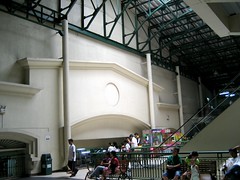
The Tutuban Center Mall (pictured above) is located at the forefront of Divisoria at Claro M. Recto Avenue (formerly Azcarraga Street) right off Jose Abad Santos Avenue. It is near Tutuban Railroad Station whose trains run from Manila to Dagupan, Pangasinan. In 1886 the Manila Railway Company commissioned the Fleming Company to help build this railroad. The tracks cut across Tondo, which uprooted many impoverished residents from their homes, including the family of our national hero, Andres Bonifacio. To this day, over a hundred years later, the trains still run through the Tutuban station.
This area is and has always been one of Manila’s bustling commercial hubs. From Divisoria’s wholesale distributors to myriad retailers selling various kinds of items such as clothes, jewelry, and housewares at bargain prices. The Tutuban Center Mall has stores that offer most of these items, including many assortments of foodstuffs and delicacies, as well as a wide array of local handicrafts
The name Tutuban means the place where they make tuba (defined by Milkphish of Bughaw as an alcoholic drink made from palm flower sap, though native to the Philippines, is widely sold in the cities of Mexico by street vendors called Tuberos).
Labels: Divisoria, Manila history
posted by Señor Enrique at 10:27 AM
| 20 comments
![]()
![]()






